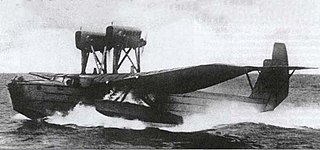
The Tupolev Tu-126 was an airborne early warning and control aircraft developed from the Tupolev Tu-114 airliner by the Tupolev design bureau. It was in service with the armed forces of the Soviet Union from 1965 to 1984.

The Tupolev Tu-4 is a piston-engined Soviet strategic bomber that served the Soviet Air Force from the late 1940s to mid-1960s. It was an unlicensed, reverse-engineered copy of the American Boeing B-29 Superfortress.

The Tupolev Tu-85 was a Soviet prototype strategic bomber based on the Tu-4, an unlicensed, reverse engineered copy of the Boeing B-29 Superfortress. It was the ultimate development of the B-29 family, being over 50% heavier than its progenitor and had nearly double the range. Only two prototypes were built before the program was cancelled in favor of the turboprop powered Tupolev Tu-95 bomber which could cover the same range at a far higher speed.

The Tupolev Tu-80 was a Soviet prototype for a longer-ranged version of the Tupolev Tu-4 bomber, an unlicensed, reverse engineered copy of the Boeing B-29 Superfortress. It was cancelled in 1949 in favor of the Tupolev Tu-85 program which offered even more range. The sole prototype was used in various test programs before finally being used as a target.
The Tupolev Tu-70 was a Soviet passenger variant of the Tu-4 bomber, an unlicensed, reverse engineered copy of the Boeing B-29 Superfortress. Designed immediately after the end of World War II, it used a number of components from Boeing B-29s that had made emergency landings in the Soviet Union after bombing Japan. It had the first pressurized fuselage in the Soviet Union and first flew on 27 November 1946. The aircraft was successfully tested, recommended for serial production, but ultimately not produced because of more pressing military orders and because Aeroflot had no requirement for such an aircraft. A military cargo aircraft version was the Tupolev Tu-75.

The Tupolev Tu-22 was the first supersonic bomber to enter production in the Soviet Union. Manufactured by Tupolev, the Tu-22 entered service with the Soviet military in the 1960s.

The Tupolev Tu-95 is a large, four-engine turboprop-powered strategic bomber and missile platform. First flown in 1952, the Tu-95 entered service with the Long-Range Aviation of the Soviet Air Forces in 1956 and was first used in combat in 2015. It is expected to serve the Russian Aerospace Forces until at least 2040.

The Tupolev Tu-98 was a prototype swept wing jet bomber developed by Tupolev for the Soviet Union.

The Tupolev Tu-14, was a Soviet twinjet light bomber derived from the Tupolev '73', the failed competitor to the Ilyushin Il-28 'Beagle'. It was used as a torpedo bomber by the mine-torpedo regiments of Soviet Naval Aviation between 1952–1959 and exported to the People's Republic of China.

The Tupolev TB-1 was a Soviet bomber aircraft, an angular monoplane that served as the backbone of the Soviet bomber force for many years, and was the first large all-metal aircraft built in the Soviet Union.

The Tupolev TB-3 was a monoplane heavy bomber deployed by the Soviet Air Force in the 1930s and used during the early years of World War II. It was the world's first cantilever wing four-engine heavy bomber. Despite obsolescence and being officially withdrawn from service in 1939, the TB-3 performed bomber and transport duties throughout much of World War II. The TB-3 also saw combat as a Zveno project fighter mothership and as a light tank transport.

The Tupolev ANT-40, also known by its service name Tupolev SB and development co-name TsAGI-40, was a high speed twin-engined three-seat monoplane bomber, first flown in 1934. The Tupolev design was advanced but lacked refinement, much to the dismay of crews, maintenance personnel, and Stalin, who pointed out that "there are no trivialities in aviation".

The ANT-8 was an experimental flying boat designed by Tupolev. It was designated the "MDR-2" by the military.

The Tupolev Tu-12 was an experimental Soviet jet-powered medium bomber developed from the successful piston-engined Tupolev Tu-2 bomber after the end of World War II. It was designed as an interim aircraft to familiarize Tupolev and the Soviet Air Forces (VVS) with the issues involved with jet-engined bombers.

The Tupolev ANT-35 was a 1930s Soviet twin-engined light transport monoplane that entered service with Aeroflot in 1937 as the Tupolev PS-35.

The Tupolev I-14 was a Soviet fighter aircraft of the 1930s. It was a single-engined, single-seat monoplane with retractable undercarriage, designed to carry heavy armament, and as such was one of the most advanced fighters of its time. It was ordered into production, but this was cancelled after only a small number had been built, the competing Polikarpov I-16 being preferred.
The Tupolev ANT-10 was a prototype single-engined light bomber/reconnaissance aircraft of the 1930s. Only a single example was built, the Polikarpov R-5 being preferred.
The Tupolev ANT-21 was a Soviet twin-engined four-seat heavy fighter, which also had the designation MI-3. It was not accepted for production, only two prototypes being built.
The Tupolev ANT-41 was a prototype Soviet twin-engined torpedo-bomber of the 1930s. A single prototype was built, which was destroyed in a crash. No production followed, with the Ilyushin DB-3 serving as a torpedo bomber instead.

The Tupolev '73',, was a Soviet trijet medium bomber of the late 1940s. It lost out to the Ilyushin Il-28 'Beagle'.